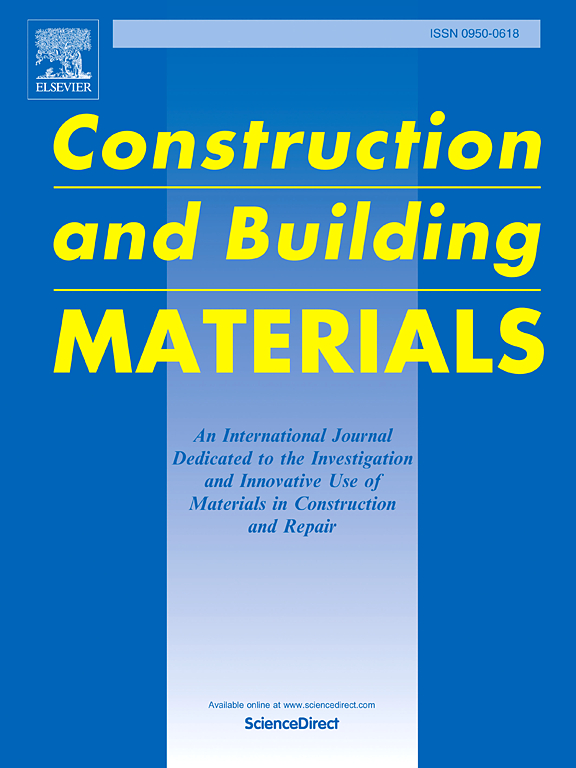Experimental investigation on the influence of rice straw characteristics on the hygric, thermal and mechanical properties of straw-lime concretes
IF 7.4
1区 工程技术
Q1 CONSTRUCTION & BUILDING TECHNOLOGY
引用次数: 0
Abstract
The utilization of agricultural wastes in the construction sector has experienced impressive expansion due to the growing awareness of climate change. These materials provide a fascinating solution to reduce the energy demand and consequential carbon emissions, thanks to their attractive thermal, hygroscopic and environmental properties. In this context, the present study examines the impact of the characteristics of rice straw particles on the mechanical, hygric and thermal properties of straw concretes. The characterization of the concretes is mainly based on measurements of thermal conductivity, water vapor permeability, moisture buffering capacity, and mechanical properties. Several formulations are defined and tested by varying the type of straw particles and their sampling area on the stem. First, the impact of grinding process of rice straw on concretes incorporating these particles was evaluated. A comparison was made between concretes containing cut particles in the longitudinal direction with a tubular shape with concretes containing milled particles (flatter shape) of similar length. Then, the dependence of the physical and chemical properties of straw particles on their shape and sampling area on the stem is identified. The results showed that the properties of concretes are highly dependent on the shape and sampling area of straw particles. The dependence of the mechanical, thermal and hygric performances of concretes on the particles shape appears to be the most relevant parameter, while the variation in concrete performances based on sampling area is limited. Additionally, the results show that cut particles induce lighter and porous concretes compared to milled particles, leading to an attractive thermal conductivity, moisture buffering capacity and water vapor permeability, while decreasing the mechanical properties of concretes. It is also highlighted that particles extracted from the bottom of the stem exhibit excellent hygric properties, higher deformation capacity and lower thermal conductivity than particles from the top of the stem.
稻草特性对稻草-石灰混凝土水、热、力学性能影响的试验研究
由于对气候变化的认识日益增强,建筑部门对农业废物的利用得到了令人印象深刻的扩大。这些材料提供了一个迷人的解决方案,以减少能源需求和随之而来的碳排放,由于其吸引人的热,吸湿性和环境特性。在这种情况下,本研究探讨了稻草颗粒的特性对稻草混凝土的机械、水力学和热性能的影响。混凝土的表征主要基于热导率、水蒸气渗透性、水分缓冲能力和机械性能的测量。通过改变秸秆颗粒的类型及其在茎上的取样面积来定义和测试几种配方。首先,评估了稻草研磨过程对含这些颗粒的混凝土的影响。比较了纵向上含有切割颗粒的管状混凝土与长度相近的含有研磨颗粒(扁平形状)的混凝土。然后,确定了秸秆颗粒的物理化学性质与其形状和秸秆取样面积的依赖关系。结果表明,秸秆颗粒的形状和取样面积对混凝土的性能有很大的影响。混凝土的力学、热工和水工性能与颗粒形状的关系似乎是最相关的参数,而基于采样面积的混凝土性能变化是有限的。此外,研究结果表明,与研磨颗粒相比,切割颗粒诱导的混凝土更轻、更多孔,从而提高了混凝土的导热性、水分缓冲能力和水蒸气渗透性,同时降低了混凝土的力学性能。研究还强调,从茎杆底部提取的颗粒比从茎杆顶部提取的颗粒具有优异的水力学性能,更高的变形能力和更低的导热性。
本文章由计算机程序翻译,如有差异,请以英文原文为准。
求助全文
约1分钟内获得全文
求助全文
来源期刊

Construction and Building Materials
工程技术-材料科学:综合
CiteScore
13.80
自引率
21.60%
发文量
3632
审稿时长
82 days
期刊介绍:
Construction and Building Materials offers an international platform for sharing innovative and original research and development in the realm of construction and building materials, along with their practical applications in new projects and repair practices. The journal publishes a diverse array of pioneering research and application papers, detailing laboratory investigations and, to a limited extent, numerical analyses or reports on full-scale projects. Multi-part papers are discouraged.
Additionally, Construction and Building Materials features comprehensive case studies and insightful review articles that contribute to new insights in the field. Our focus is on papers related to construction materials, excluding those on structural engineering, geotechnics, and unbound highway layers. Covered materials and technologies encompass cement, concrete reinforcement, bricks and mortars, additives, corrosion technology, ceramics, timber, steel, polymers, glass fibers, recycled materials, bamboo, rammed earth, non-conventional building materials, bituminous materials, and applications in railway materials.
 求助内容:
求助内容: 应助结果提醒方式:
应助结果提醒方式:


